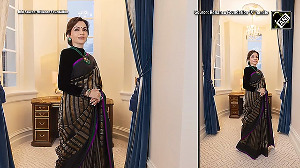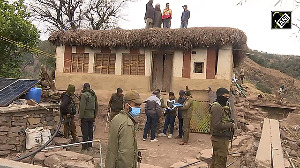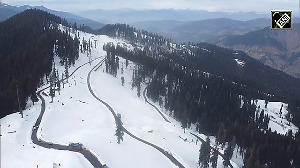'The past year has yielded extraordinary results in the strategic, commercial, and people-to-people components of the India-United States partnership, US Ambassador to India Richard Rahul Verma tells Aziz Haniffa/Rediff.com in an exclusive interview.

In January 2015, when Richard Rahul Verma took over as the US Ambassador to India -- the first Indian American appointed to the post -- he hit the ground running.
US President Barack Obama was to arrive within days to attend India's Republic Day celebrations as the chief guest.
In the months since then Prime Minister Narendra Modi and President Obama have met twice (another meeting is on the cards later this month when the Nuclear Security Summit takes place in Washington, DC), there have been several high-level visits and Congressional delegations to India.
Verma has travelled to as many as 17 Indian states to connect with the people of the country and the pace has shown no signs of letting up. And Verma likes it that way.
In the first of a three-part exclusive interview with Aziz Haniffa/Rediff.com, the Ambassador looks back at the milestones and challenges of the past year.
How fulfilling has the past year been?
2015 was a historic year in Indo-US relations. The credit for that goes to Prime Minister Modi and President Obama, and so many others who have worked so hard on the relationship over many decades.
It has been a great honour to be here as Ambassador during this time -- both humbling and inspiring.
Following President Obama's historic visit last year as the first American President invited to be chief guest at the Republic Day celebration, my team and I dedicated ourselves to achieving the ambitious strategic vision laid out by the President and Prime Minister Modi.
As we look back over last year, 2015 yielded extraordinary results in the strategic, commercial, and people-to-people components of our partnership.
We established secure lines of communication between South Block and the West Wing, which are frequently used by the President and prime minister and our national security advisors.
We launched the first-ever strategic and commercial dialogue, bringing a whole-of-government approach to our annual engagement, and we continued to push forward on the 30-plus working groups and government-to-government dialogues that cover everything from space cooperation, cyber security, global health security, and civil aviation.
On the economic front, two-way trade now stands at $104 billion (over Rs 7 lakh crore/Rs 7 trillion), compared to $30 billion (over Rs 2 lakh crore/Rs 2 trillion) just 10 years ago, and our sights are set on increasing this figure to $500 billion (Rs 33.6 lakh crore).
In the final three months of 2015, bilateral trade increased by well over $5 billion (Rs 33,655 crore/Rs 336 billion), including a $2.6 billion (Rs 17,500 crore/Rs 175 billion) agreement for GE to provide India's railway network with next generation locomotives, many of which will be made in India.
The number of US companies operating in India today has more than doubled over the past 10 years.
Our people-to-people ties continue to know no bounds.
More than 132,000 Indian students now study in the US. The growth in Indian students was greater than from any other country, and India is second only to China in the number of students currently in the US.
This past year, we processed over 1 million visa applications -- the highest on record.

What are the highlights -- those that have led to a tangible ramping up of the Indo-US strategic partnership? And, as the administration is into its final year, what is on the cards to add oomph to the progress already made?
Some of the highlights of the past year signal a new era in our strategic partnership.
They include not just defence ties, but also progress in addressing threats such as climate change and health.
India and US endorsed a common vision for the security of the Asia-Pacific and Indian Ocean region based on our shared commitment to the rules-based international systems that have safeguarded peace and prosperity for seven decades.
We executed Malabar 2015 -- our most complex joint naval exercise ever in the Indian Ocean.
During this year's exercise we welcomed Japan as a regular participant and mobilised over 8,000 personnel, including participation from a US Carrier Strike Group, US and Indian submarines, P-8 maritime surveillance aircraft, and a Japanese destroyer.
We launched the Defence Technology and Trade Initiative, further integrating our defence cooperation and industries and creating a boost for the Make in India initiative.
Under DTTI, we launched joint working groups on aircraft carrier and jet engine technology, which will help bolster Indian maritime and aerospace capabilities.
In December, Manohar Parrikar became the first Indian defence minister to visit the US Pacific Command and, earlier in the year, Secretary Carter became the first US defense secretary to visit an Indian military command.
Building on the success of our military-to-military ties, our special operations forces trained together last month, and we look forward to India joining this year's Red Flag aerial exercise.
On the climate front, we launched the Fulbright-India climate fellowship, expanded our Partnership to Advance Clean Energy research, and established a new fund to hasten the commercialisation of innovative, off-grid clean-energy solutions.
Our countries worked together to phase down the production and consumption of super greenhouse gases, known as hydrofluorocarbons, by strengthening the Montreal Protocol.
In Paris, our leaders helped broker an ambitious, transparent, and accountable global framework to combat climate change, providing a strong and irreversible market signal that the world is locking in a low-carbon future.
Addressing some of the world's most vexing public health and development challenges, US and Indian researchers helped launch the world's most inexpensive rotavirus vaccine last year, potentially saving millions of lives.
We also launched new efforts to fight TB, engaged in joint cancer research, and battled acute encephalitis together.
In the year ahead, we will work to refine and operationalise our common security vision for the Indo-Pacific region.
Though anchored in Asia, the Indo-US strategic partnership will also be a truly 21st century relationship of natural allies working together in cyberspace, global hot spots, global commons, outer space, the human genome, and the global biome.
In the same vein, what have been the major challenges, because obviously both sides probably have some qualms on certain issues? What are the specific disappointments?
The change that I have seen in the relationship is that we have the mechanisms in place for both governments to deal with their concerns directly.
The dozens of government-to-government dialogues help build trusted relationships, but also give us the opportunity to tackle big and small problems alike -- such as addressing liability for civil nuclear cooperation, negotiating a way forward on trade matters, and moving to co-production and development in defence and so many other areas.
These kinds of issues were able to be addressed and resolved through hard work and dialogue -- lots of it, and that's a good development in our ties.
On the commercial front, over the next year we are going to continue to work together on improving the ease of doing business in both countries.
We talk a lot about this in our strategic and commercial dialogue, as well as in our Trade Policy Forum.
The challenge comes from aligning two very different systems, which handle import/export, banking, investment, and regulation.
People forget that India fundamentally changed its economic policy in the early 1990s when it moved away from a centrally planned and executed economy. Did you know that in the 1990s, exports were only 8 per cent of India's $500 billion economy?
Today, India&'s GDP has more than quadrupled to $2 trillion, and exports as a share of its GDP are over 23 per cent.
So, it is on the right path.
India is still working to align itself more completely with the rapidly evolving global marketplace, and we are pleased to be working with the Indian government to assist them in their efforts.











 © 2025
© 2025